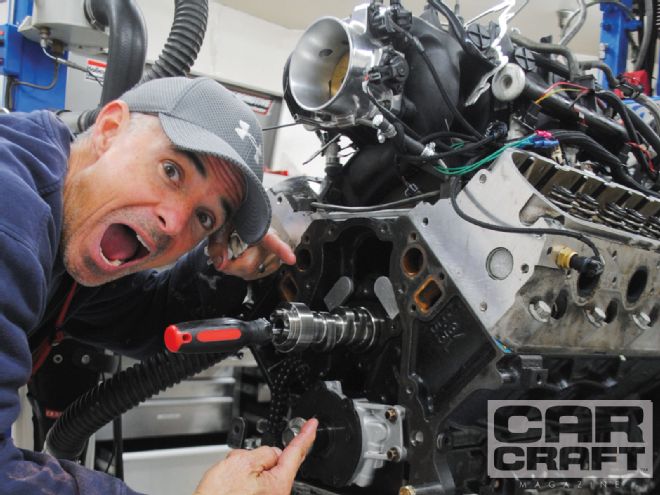
Here is a common question among LS engine enthusiasts: My buddy, Joe, just bought a new cam for his 6.0L and wants to get rid of his factory LQ9 cam. Is that a good cam for the 5.3L in my truck, for my 240SX drift car, or the LS engine I am swapping into my second-gen Camaro? In this ultimate LS cam comparo, we've answered that question, and others like: How much is an LS1 cam worth over the 5.3L? Ditto for the LS2, LS3, LS6, LS7, and LS9. Is there any difference between the LR4, early LQ4, and LM7? Heck, we even threw in the L33 (aka H.O. 5.3L), LSA, and LQ9 cam just for good measure. We wrestled with valvesprings, cams sensors, and differing bolt patterns to get all these cams into the engine and on the pump. The result is a guide that will help you select the best OE GM cam for your 5.3L build. Why stock cams? These cams can be had for pennies on the dollar and benefit from millions of dollars spent on the research and development of idle quality, longevity, and fuel mileage. Why the 5.3L? It's the most common LS engine ever made.
The 5.3L used for testing was bone stock, which required at least a valvespring upgrade for the high-lift LS9 and LS7 cams. Even the LS2, LS3, and LS6 cams offered more lift than the factory 5.3L (LM7) springs could support, to say nothing of limiting rpm potential. The spring issue was easily cured using a beehive upgrade. Next issue on the list was the fact that the LS3 and LSA cams were single-bolt that required a front cover equipped to accept a front cam sensor. The LS2 also required a front cam sensor (no provision on the cam for rear sensor), but the LS1 and all other (early) three-bolt cams required a rear sensor. The three distinct cam families also required different timing (cam) gears and a management system that allowed such hybrid mixing of crank and cam sensors. Credit the Holley Dominator EFI system for the ability to accept and tune all of the different cam profiles.
While we were on factory cams, we decided that in addition to the peak power gains, it would be interesting to document things like idle vacuum, cranking compression, and average power and torque gains lower in the rev range. In addition to running the stock cams, we also decided to run a handful of aftermarket Crane cams. With its new offerings, we were excited about both the Direct-Fit line of cams that require no spring changes and a few of the smaller performance cams with similar duration to the factory options. We wanted to know how an aftermarket cam of equal (or near-equal) duration compared with the stock stuff. With that in mind, we ventured off to the dyno. Check out the results to see how your favorite cam compared with the factory LM7.
Baseline: 5.3L LM7 Cam
Being such a diminutive factory cam, it is not surprising that power fell off so rapidly past 5,500 rpm. Run on the high-mileage 5.3L, the stock 5.3L cam produced peak numbers of 353 hp at 5,200 rpm and 384 lb-ft of torque at 4,300 rpm. It is interesting to note that the same cam was used on the smaller LR4 4.8L, and that combination (same heads, cam, and intake) makes peak power 300 rpm higher. Obviously tuned for low-speed power, torque production with the stock cam exceeded 350 lb-ft from 2,700 rpm to 5,300 rpm. We tested the LR4 and LQ4 cams, but these produced identical power to the LM7.
Baseline Test LM7 (5.3L) Camshaft
Lift 0.466/0.457 Duration 190/191 degrees LSA 116 degrees Idle vacuum 22.5 in-Hg Cranking compression 175 psi Peak power 353 at 5,200 rpm Peak torque 384 at 4,300 rpm Average HP 286 Average TQ 353 HP/TQ gains (over LM7 cam) NA 2,500 NA 3,500 NA 4,500 NA 5,500 NA 6,500 NA
LS1 vs. LM7
Measured out at 6,500 rpm, the early LS1 cam offered 63 hp over the LM7 cam, but the results illustrate that the gains did not come without a trade-off. The LM7 cam offered more low-speed torque (by as much as 22 lb-ft) up to 4,400 rpm, but the LS1 cam pulled away there after. Such is the effect of extra duration, as the LM7 cam was designed to build torque in the 5.3L. The LS1 cam would certainly offer additional performance if you kept the revs above 4,000 rpm, but know that below that point there was a torque loss.
LS Engine Designation: LS1 ('98–'00)
Displacement 5.7L Lift 0.496/0.496 Duration 202/210 degrees LSA 116 degrees Idle vacuum 21.8 inches Hg Cranking compression 165 psi Peak power 382 at 5,500 rpm Peak torque 389 at 4,800 rpm Average HP 295 Average TQ</td> 357 HP/TQ gains (over LM7 cam) at 2,500 -22 lb-ft 3,500 -11 lb-ft 4,500 0 5,500 +31 lb-ft (32 hp) 6,200 +45 lb-ft (53 hp) 6,500 51 lb-ft (63 hp)
LS2 vs. LM7
The odd thing about the LS2 test was that this was the only factory cam with which we experienced valve float. Unlike all the other cams, the LS2 did not rev cleanly to 6,500 rpm, so we limited the peak power difference to 6,200 rpm. The LS2 cam impressed with its power production, offering more than 400 hp (peak of 403 hp) and just less than 400 lb-ft (399 lb-ft). Despite a jump of 14 degrees in intake duration over the LM7 cam, the LS2 offered more than 21 inches of vacuum and lost out to the smaller cam only below 3,000 rpm.
Engine Designation: LS2
Displacement 6.0L Lift 0.525/0.525 Duration 204/211 degrees LSA 116 degrees Idle vacuum 21.1 in-Hg Cranking Compression 175 psi Peak Power 403 at 6,100 rpm Peak Torque 399 at 4,900 rpm Average HP 305 Average TQ 370 HP/TQ Gains (Over LM7 cam) at 2,500 -18 lb-ft 3,500 0 4,500 0 5,500 +46 lb-ft (48 hp) 6,200 +67 lb-ft (78 hp)
LS3 vs. LM7
Despite similar specs to the LS2 (increased intake lift), low-speed power production with the LS3 cam was down compared with the LS2. This was evident from the fact that the LM7 offered more torque up to 4,200 rpm. As expected, the LS3 offered plenty of power, producing 405 hp and 398 lb-ft of torque. This represented a peak gain of 91 hp over the LM7 at 6,500 rpm. We expected the additional lift offered by the LS3 grind to increase power over the LS2, but that was not the case on this application.
Engine Designation: LS3
Displacement 6.2L Lift 0.551/0.525 Duration 204/211 degrees LSA 117 degrees Idle vacuum 21.3 in-Hg Cranking Compression 175 psi Peak HP 405 at 6,100 rpm Peak Torque 398 at 4.900 rpm Average HP 303 Average TQ 368 HP/TQ gains (over LM7 cam) at 2,500 -21 lb-ft 3,500 -6 lb-ft 4,500 +5 lb-ft 5,500 +47 lb-ft (49 hp) 6,500 +73 lb-ft (91 hp)
LS6 vs. LM7
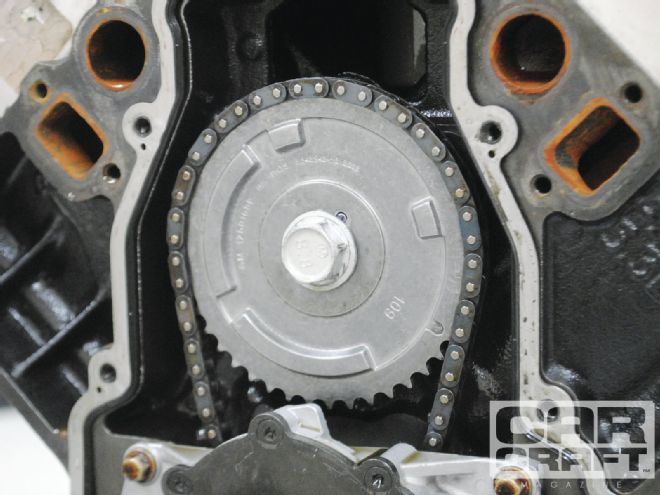 Removal of the front cover allows access to the cam sprocket. This single-bolt, 4X sprocket was used with the factory LS3 cam. We made sure to line up the cam and crank sprockets at TDC prior to each swap.
Removal of the front cover allows access to the cam sprocket. This single-bolt, 4X sprocket was used with the factory LS3 cam. We made sure to line up the cam and crank sprockets at TDC prior to each swap.
The LS6 cam is a favorite among LS enthusiasts, but it seems from this testing that it falls short on the 5.3L compared with the LS2 and LS3 grinds. The LS6 offered a few more horsepower at the top of the rev range but was down compared with the LM7 up to 4,500 rpm. Compared with the LS2 and LS3 cams, the LS6 offered less power through most of the rev range, only equaling their outputs at the very top of the rpm band.
Engine Designation: LQ9 (Shared with Late LS1)
Displacement 6.0L Lift 0.479/0.467 Duration 196/207 degrees LSA 116 degrees Idle vacuum 22.5 in-Hg Cranking compression 185 psi Peak power 376 at 5,900 rpm Peak torque 389 at 4,500 rpm Average HP 296 Average TQ 362 HP/TQ Gains (Over LM7 cam) at 2,500 -8 lb-ft 3,500 0 4,500 0 5,500 +23 lb-ft (24 hp) 6,500 +32 lb-ft (40 hp)
LQ9 vs. LM7
Though it did not offer the top-end charge of the LS2-LS6 grinds, the (late) LQ9 cam offered impressive power gains over the LM7 and would be a good upgrade for a 5.3L truck owner or someone looking to improve performance without sacrificing low-speed torque production. The slight loss of 8 lb-ft was more than offset by the 40 extra horsepower at the top. It's important to note that the power gains offered here would likely be magnified had we tested the cams on a larger 6.0L.
Engine Designation: LQ9 (Shared with Late LS1)
Displacement 6.0L Lift 0.479/0.467 Duration 196/207 degrees LSA 116 degrees Idle vacuum 22.5 in-Hg Cranking compression 185 psi Peak power 376 at 5,900 rpm Peak torque 389 at 4,500 rpm Average HP 296 Average TQ 362 HP/TQ Gains (Over LM7 cam) at 2,500 -8 lb-ft 3,500 0 4,500 0 5,500 +23 lb-ft (24 hp) 6,500 +32 lb-ft (40 hp)
L33 vs. LM7
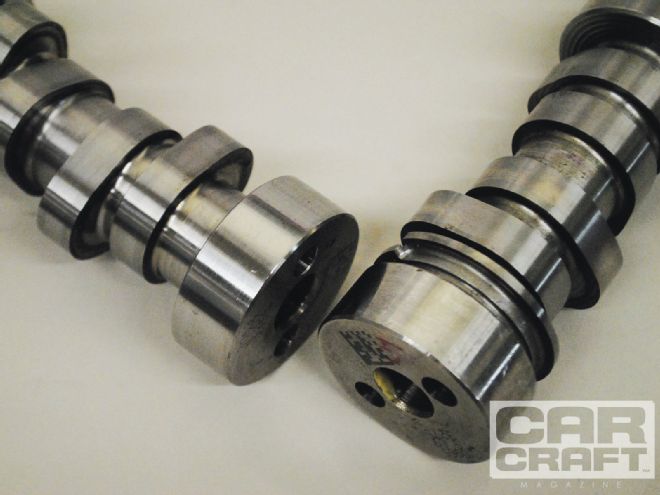 The early cams featured provisions for rear cam sensors (right), while later cams relied on the cam sprockets and a front cam sensor.
The early cams featured provisions for rear cam sensors (right), while later cams relied on the cam sprockets and a front cam sensor.
Contrary to popular belief, the L33 cam is not the same as the LQ9 grind. The L33 was essentially a high-lift version of the LM7 with a few extra degrees of duration. In terms of power, the L33 offered additional power over the LM7 cam but did not increase power as much as the LQ9. As expected, there was no change to idle vacuum, and cranking compression was within a few psi of the LM7. Though the L33 offered more power than the mild LM7, it's hardly worth the effort. Grab one of the hotter factory (or Crane) cams if you are going to upgrade.
Engine Designation: L33 (H.O. 5.3L)
Displacement 5.3L Lift 0.479/0.479 Duration 193/193 degrees LSA 116 degrees Idle vacuum 22.4 in-Hg Cranking compression 182 psi Peak power 362 at 5,300 rpm Peak torque 387 at 4,500 rpm Average HP 290 Average TQ 357 HP/TQ gains (over LM7 cam) at 2,500 -4 lb-ft 3,500 0 4,500 +4 lb-ft 5,500 +9 lb-ft (10 hp) 6,200 +12 lb-ft (14 hp)
LS7 vs. LM7 (Plus Rockers)
With the highest lift and longest duration of any factory cam, it was not surprising that the LS7 offered the greatest power gains. Since the LS7 was designed to be run with 1.8 rockers, we ran the cam both ways. Equipped with 1.7 rockers, the LS7 cam increased peak power from 353 hp and 384 lb-ft to 422 hp and 395 lb-ft. Up to 4,500 rpm, the LM7 offered more power, but the LS7 pulled strong all the way to 6,500 rpm. Installation of the 1.8 bolt-in aluminum roller rockers from Crane increased peak power by another 10–12 hp but resulted in an earlier valve-float point. Adding dual-springs would solve that problem.
Engine Designation: LS7
Displacement 7.0L Lift 0.558/0.558 w/1.7:1-0.591/0.59 w/1.8:1 Duration 211/230 degrees LSA 121 degrees Idle vacuum 19.6 in-Hg Cranking Compression 162 psi Peak Power 422 at 6,300 rpm Peak Torque 395 at 5,000 rpm Average HP 300 Average TQ 361 HP/TQ gains (over LM7 cam) at 2,500 -40 lb-ft 3,500 -19 lb-ft 4,500 0 5,500 +51 lb-ft (53 hp) 6,500 +92 lb-ft (115 hp)
LS9 vs. LM7
Given the similarity in specs, it is not surprising that the power curve offered by the LS9 mimicked that of the LS7 with 1.7 rockers. The LS7 offered slightly more peak power, but only slightly. We did not run the LS9 with 1.8 rockers, as the LS9 was factory-equipped with 1.7 LS3-based rockers. Equipped with the LS9 cam, the 5.3L produced 420 hp and 393 lb-ft of torque. Note that peak torque production never varied by more than 15 lb-ft with any of the factory cams; the duration simply shifted the torque curve higher or lower in the rev range. Whereas the LM7 produced peak torque at just 4,300 rpm, the LS7 and LS9 cams produced peak torque 700–800 rpm higher.
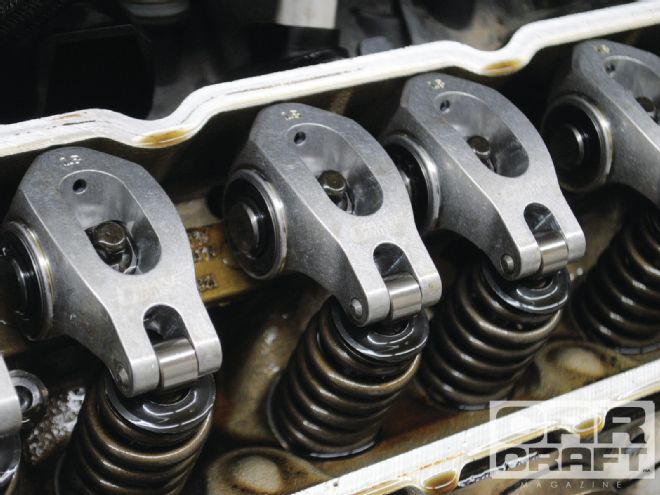 Since the LS7 was designed to run with 1.8-ratio rockers, we ran it both ways on our 5.3L. Obviously, the (offset) stock 1.8 LS7 rockers would not work on the 5.3L heads, so we installed a set of bolt-on 1.8 aluminum rockers from Crane Cams. The LS7 cam responded to the rocker change to the tune of 10–12 hp, but adequate valvespring pressure is a must.
Since the LS7 was designed to run with 1.8-ratio rockers, we ran it both ways on our 5.3L. Obviously, the (offset) stock 1.8 LS7 rockers would not work on the 5.3L heads, so we installed a set of bolt-on 1.8 aluminum rockers from Crane Cams. The LS7 cam responded to the rocker change to the tune of 10–12 hp, but adequate valvespring pressure is a must.
Engine Designation: LS9
Displacement 6.2L Lift 0.558/0.562 Duration 211/230 degrees LSA 122.5 degrees Idle vacuum 20.1 in-Hg Cranking Compression 163 psi Peak Power 420 at 6,200 rpm Peak Torque 393 at 5,100 rpm Average HP 303 Average TQ 360 HP/TQ Gains (Over LM7 cam) at 2,500 -41 lb-ft 3,500 -20 lb-ft 4,500 -2 lb-ft 5,500 +51 lb-ft (53 hp) 6,500 +90 lb-ft (112 hp)
LSA vs. LM7
Designed for the supercharged Cadillac CTS-V and Camaro ZL-1, the LSA cam offered plenty of power on the normally aspirated 5.3L. The peak numbers jumped from 353 hp and 384 lb-ft to 389 hp and 394 lb-ft. The mild intake duration of just 198 degrees limited power production higher in the rev range, but the extra exhaust duration allowed the power to carry much better than the LM7. The 33hp difference between the LSA and LS9 cams is a clear indication as to why the LS9 cam is such an attractive upgrade for ZL-1 and CTS-V owners.
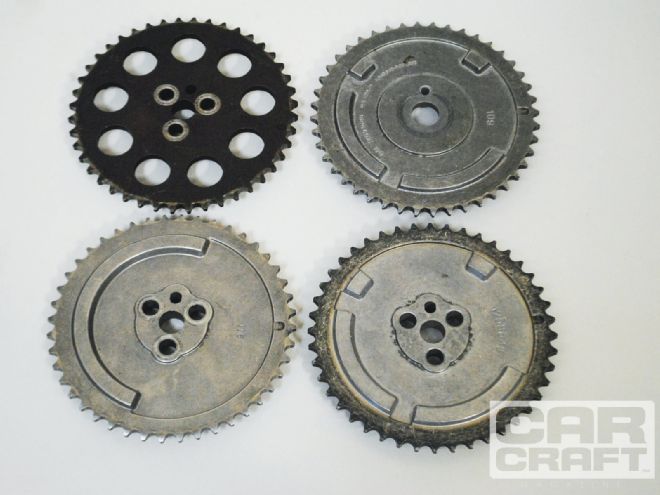 This shot illustrates the four distinct cam sprockets offered in the various LS motors, including the standard three-bolt (top left), the three-bolt 1X (bottom left), the three-bolt 4X (bottom right), and the single-bolt 4X (top right). In reality, the Holley Dominator EFI system allowed us to test the cams without the need for a cam sensor.
This shot illustrates the four distinct cam sprockets offered in the various LS motors, including the standard three-bolt (top left), the three-bolt 1X (bottom left), the three-bolt 4X (bottom right), and the single-bolt 4X (top right). In reality, the Holley Dominator EFI system allowed us to test the cams without the need for a cam sensor.
Engine Designation: LSA
Displacement 6.2L Lift 0.480/0.480 Duration 198/216 degrees LSA 122.5 degrees Idle vacuum 21.8 in-Hg Cranking compression 184 psi Peak power 389 at 5,600 rpm Peak torque 394 at 4,800 rpm Average HP 300 Average TQ 365 HP/TQ gains (over LM7 cam) at 2,500 -27 lb-ft 3,500 -3 lb-ft 4,500 +8 lb-ft 5,500 +37 lb-ft (38 hp) 6,500 +54 lb-ft (68 hp)
Crane Cam Trio vs. LM7
To finish up the Ultimate LS cam test, we decided to test a trio of LS grinds offered by Crane Cams. The cams range from a mild Direct-Fit cam, designed to drop right into a 5.3L truck or other LS application without need to swap springs, to a healthy (but still streetable) performance grind that offered up 130 hp over the factory LM7. The first cam from Crane offered 0.502-inch lift, 200 degrees of duration, and a 113-degree LSA. This Direct-Fit cam offered substantial torque gains, besting all of the factory offerings for peak torque production—impressive given the mild specs (smaller than most of the factory offerings). The Direct-Fit line is perfect for LS owners looking to swap cams without the need to change springs. Cam number two sported 0.551 lift, a 210/218 duration split and 116-degree LSA (think LS6 with slightly more intake duration). This cam offered 411 hp and 406 lb-ft of torque, bettering the LM7 from 2,800 rpm through 6,500 rpm while besting the LS2, LS3 and LS6 grinds. The final cam was the high-horsepower and torque champ of the test, with 0.590 lift, a 224/232 duration split and 115-degree LSA. This cam shared the exhaust specs with the LS7 and LS9 and lift specs with the LS7 (with 1.8 rockers). The 224 cam from Crane increased the power output of the 5.3L to an impressive 442 hp and 412 lb-ft of torque while offering less of a trade off in low-speed torque than the LS6, LS7, or LS9 grinds. In fact, the 224 cam was consistently up by 25 lb-ft over the LS7 and LS9 cams and equaled or bettered the LM7 cam from 2,900 rpm to 6,500 rpm.
Crane Cam Trio: 200, 210, 224 Engine Designation: LS
Crane Came Trio 200 210 224 Displacement 4.8L–6.2L Lift 0.502/0.502 0.551 0.590 Duration 200/200 degrees 210/218 degrees 224/232 degrees LSA 113 degrees 116 degrees 115 degrees Idle vacuum 22.6 in-Hg 20.3 in-Hg 17.8 in-Hg Cranking compression 188 psi 182 psi 176 psi Peak power 380 at 5,400 rpm 411 at 6,000 rpm 442 at 6,200 rpm Peak torque 401 at 4,700 rpm 406 at 4,700 rpm 412 at 5,000 rpm Average HP 302 311 315 Average TQ 371 378 380 TQ gains (over LM7 cam) at 2,500 0 lb-ft -10 lb-ft -25 lb-ft 3,500 +14 lb-ft -9 lb-ft -8 lb-ft 4,500 +15 lb-ft +15 lb-ft +16 lb-ft 5,500 +29 lb-ft (30 hp) +55 lb-ft (57 hp) +69 lb-ft (72 hp) 6,500 +32 lb-ft (40 hp) +80 lb-ft (99 hp) +105 lb-ft (130 hp)